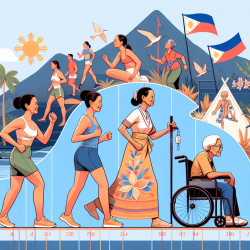Introduction
The aging population is a global phenomenon, and understanding the trajectories of functional limitations in midlife to early old age is crucial for practitioners, especially those involved in special education and therapy services. The research article titled "Functional Limitation Trajectories and Their Determinants Among Women in the Philippines" offers valuable insights into the patterns of functional limitations among women in a developing country context. This blog explores how practitioners can leverage these findings to enhance their skills and encourage further research.
Understanding Functional Limitation Trajectories
The study conducted by Zimmer et al. (2017) examines the prevalence and patterns of functional limitations among women in the Philippines, using data from the Cebu Longitudinal Health and Nutrition Study. The research identifies four distinct trajectories of functional limitations between the ages of 30 and 70: robust, late onset, early onset, and recovery. These trajectories are influenced by various factors, including marital status, household type, education, and socioeconomic status.
Key Findings and Implications for Practitioners
- Marital Status and Household Type: The study found that being married and living in a nuclear household are associated with more favorable functional limitation trajectories. Practitioners should consider these social factors when designing interventions and support systems for aging women.
- Education and Socioeconomic Status: Higher education levels correlate with healthier trajectories, while wealth and urbanicity showed unexpected results. This highlights the need for practitioners to consider the broader socioeconomic context when addressing functional limitations.
- Health Indicators: Early-life health indicators such as body mass index (BMI) and chronic conditions significantly impact functional limitation trajectories. Practitioners should incorporate health assessments into their practice to identify at-risk individuals early.
Encouraging Further Research
The study underscores the complexity of functional limitation trajectories and the need for further research to understand these patterns in different contexts. Practitioners are encouraged to explore how these findings can be applied to other populations and settings, particularly in developing countries experiencing rapid population aging.
Conclusion
Understanding the trajectories of functional limitations is vital for practitioners working with aging populations. The insights from the research on Filipino women provide a framework for identifying at-risk individuals and tailoring interventions accordingly. By considering social, economic, and health factors, practitioners can improve outcomes for their clients and contribute to the broader understanding of global health trends.
To read the original research paper, please follow this link: Functional limitation trajectories and their determinants among women in the Philippines.










